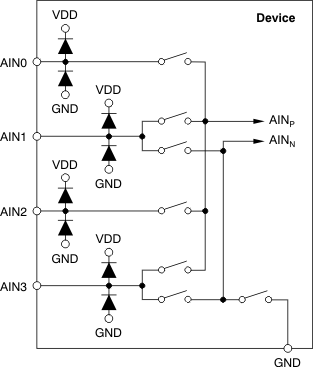SBAS741B October 2015 – April 2020 ADS1018-Q1
PRODUCTION DATA.
- 1 Features
- 2 Applications
- 3 Description
- 4 Revision History
- 5 Device Comparison Table
- 6 Pin Configuration and Functions
- 7 Specifications
- 8 Detailed Description
- 9 Application and Implementation
- 10Power Supply Recommendations
- 11Layout
- 12Device and Documentation Support
- 13Mechanical, Packaging, and Orderable Information
8.3.1 Multiplexer
The ADS1018-Q1 contains an input multiplexer (mux), as shown in Figure 8. Either four single-ended or two differential signals can be measured. Additionally, AIN0, AIN1, and AIN2 can be measured differentially to AIN3. The multiplexer is configured by bits MUX[2:0] in the Config register. When single-ended signals are measured, the negative input of the ADC is internally connected to GND by a switch within the multiplexer.
 Figure 8. Input Multiplexer
Figure 8. Input Multiplexer When measuring single-ended inputs, the device does not output negative codes. These negative codes indicate negative differential signals; that is, (V(AINP) – V(AINN)) < 0. Electrostatic discharge (ESD) diodes to VDD and GND protect the ADS1018-Q1 inputs. To prevent the ESD diodes from turning on, keep the absolute voltage on any input within the range given in Equation 1:
If the voltages on the input pins can possibly violate these conditions, use external Schottky diodes and series resistors to limit the input current to safe values (see the Absolute Maximum Ratings table).
Also, overdriving one unused input on the ADS1018-Q1 may affect conversions currently taking place on other input pins. If overdriving unused inputs is possible, clamp the signal with external Schottky diodes.